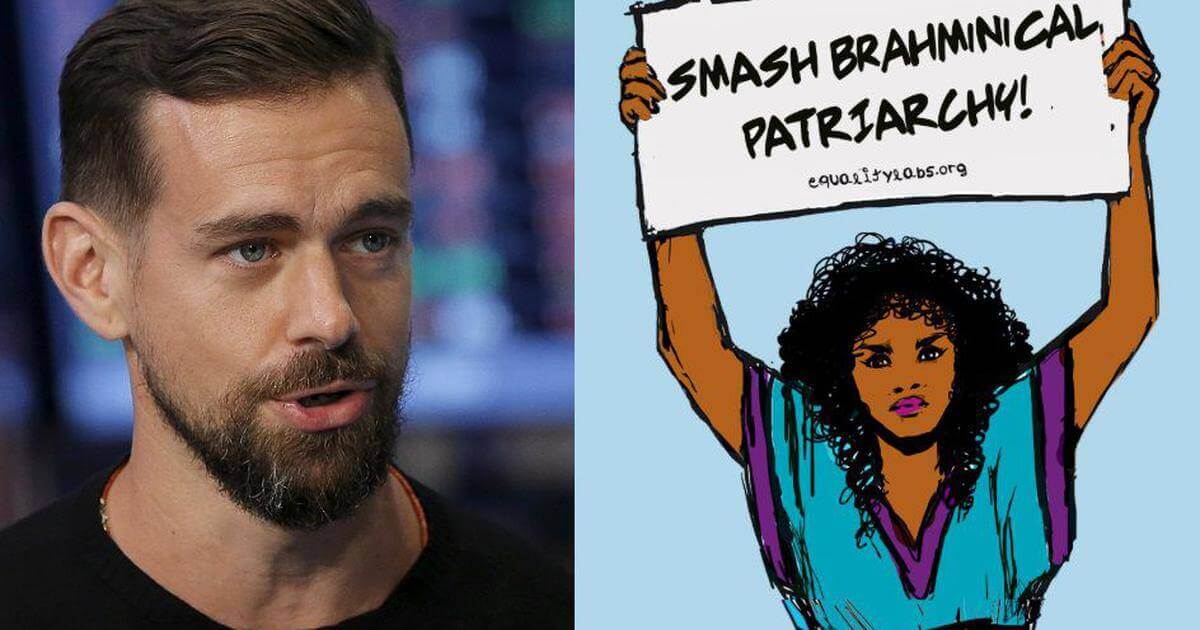During a recent visit of Twitter CEO, Jack Dorsey, to India; Twitter India hosted a closed-door discussion on November 18, 2018, with women journalists, activists and writers from India to understand their experiences on Twitter. At the end of the discussion, in a group picture, Jack Dorsey is seen holding a poster with the terms ‘Smash Brahmanical Patriarchy’ written on it which was gifted to him by Aruna Sanghapali, a Dalit rights activist who was one among the women invited. Ever since the picture was shared on Twitter, the social media platform is flooded with interpretations of the terms used in the poster and has witnessed a huge backlash over the linkage of caste and patriarchy, perhaps a ‘brahmanical’ backlash!
What is ‘Brahmanical Patriarchy’?
The furious reaction of the Twitteratis was mainly due to the misinterpretation of the term ‘Brahmanical Patriarchy’. Hence, it becomes significant to understand the contextual meaning of the term with respect to Indian social realities.
Caste is still deep-rooted in Indian social fabric and plays a major role in determining the identity of a person. The social systems, means of livelihood and social institutions are evolved from or function adhering to the customs and protocols of the caste system. Even today, the practices are observed earnestly, irrespective of rural or urban areas. It is an argued fact that the urban population of the country is far from getting affected by caste fault lines. These are the same urban ignorant people, who would never allow their sons to marry a lower caste woman and would abandon their daughter for marrying a lower caste man. Though not starkly, caste-based discrimination or caste-based patriarchy still thrives in a majority of urban households too. This holds true for all the levels of the caste-based Varna system.
The archaic state was clearly both a class state and a patriarchal state; in the case of India, there has been a close connection between caste, class, and the state which together functioned as the structural framework of institutions within which gender relations were organized. (Chakravarti, 1993). For the upper caste women, patriarchy was in the form of complete control of their sexuality to preserve land, women and caste purity. For the lower caste women in traditional societies even today, it means complete subjugation to the gender discrimination by men in their own caste, to the caste privileges of the upper caste men and also to the caste-based discrimination by the upper caste women. The recent beheading of a Tamil Nadu Dalit girl in October 2018, for rejecting sexual advances of a neighbour who is a caste Hindu says all about the caste induced powers of men in Indian society. The term ‘Brahmanical Patriarchy’ comprehensively denotes or emphasizes on this form of patriarchy and collective discrimination on all women of all castes in India that stems from the beliefs and anxiety of the men along the caste lines dictated majorly by the top level leaders, the Brahmins.
Current scenario
It was through Twitter that the #Metoo movement had kick-started and gained momentum in India. It had created a space for women from all backgrounds, irrespective of their caste, class or position of power to share their experiences of any kind of abuse or gender discrimination. At the roundtable with Jack Dorsey, Aruna Sanghapali did just that. By raising concerns over the types of discrimination a Dalit woman has to face and by gifting the poster to Jack Dorsey, she highlighted the issue of the deep-rooted intersectionality of caste and patriarchy in India and the failure of Twitter to address caste-based abusing of women over the platform.
By apologizing for holding the poster that hurt the sentiments of a section of users (majorly upper caste) and by claiming that it was meant to be a private photo, the team of Twitter India and the CEO has, in fact, shifted the blame on the women who shared the picture on Twitter and had also disappointed the only Dalit activist who attended the meeting. The reaction that followed over the poster and the meeting itself backfired on the women, making them more vulnerable to abuses, trolls and intense criticism. The act of apology and expressing regret, without even understanding the context of the term ‘Brahmanical Patriarchy’, comes out as succumbing to the pressure from the majority of the ignorant social media users and giving them an evident sense of conformity to their sense of pride, thoughts, misinterpretations and ignorance.
It is with the help of the discussions that Twitter India hosted, a public discourse can take place over issues of social change. Also, it is in such circumstances, that our ideas demand action and testify our advocacy for a particular cause. The Twitter India team could have briefed the CEO about the supremacy of the caste system and the patriarchy intertwined with it. By understanding the problem at its whole, a balanced acknowledging justification, strengthening the oppressed could have been meted out by a social media platform like Twitter, which has the potential to bring an effect outside the virtual world too. However, ironically, the entire episode has been largely successful in highlighting the mismanagement, the hypocrisy of the corporate giant, Twitter and ultimately in marginalizing the marginalized, once again!
References
Chakravarti, U. (1993). Conceptualising Brahmanical Patriarchy in- Early India - Gender, Caste, Class and State. Economic & Political Weekly.
Tamil Nadu: Dalit girl beheaded by neighbour for rejecting advances. (2018, October 31). The Indian Express.
Nair, S. (2018, November 21). Upper-caste backlash makes Twitter cut sorry figure. The Indian Express.Retrieved from https://indianexpress.com/article/technology/tech-news-technology/twitter-jack-dorsey-photo-5456455/
Image Credit: Scroll.in

